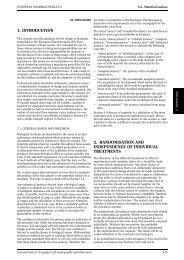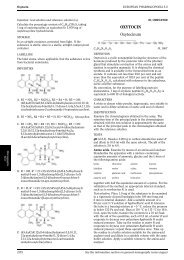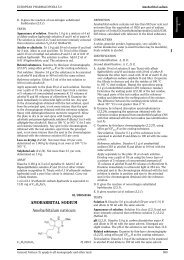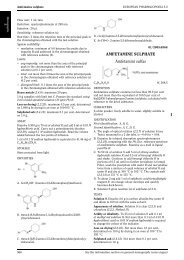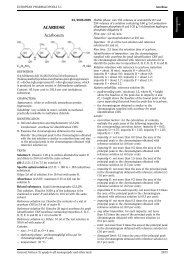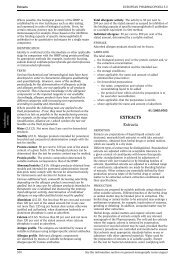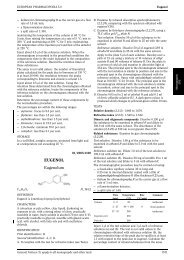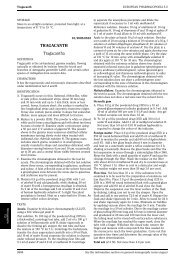FLURBIPROFEN Flurbiprofenum
FLURBIPROFEN Flurbiprofenum
FLURBIPROFEN Flurbiprofenum
Create successful ePaper yourself
Turn your PDF publications into a flip-book with our unique Google optimized e-Paper software.
Flurbiprofen EUROPEAN PHARMACOPOEIA 5.0<br />
A. Melting point (2.2.14) : 114 °C to 117 °C.<br />
B. Dissolve 0.10 g in 0.1 M sodium hydroxide and dilute to<br />
100.0 ml with the same alkaline solution. Dilute 1.0 ml of<br />
the solution to 100.0 ml with 0.1 M sodium hydroxide.<br />
Examined between 230 nm and 350 nm (2.2.25), the<br />
solution shows an absorption maximum at 247 nm. The<br />
specific absorbance at the maximum is 780 to 820.<br />
C. Examine by infrared absorption spectrophotometry<br />
(2.2.24), comparing with the spectrum obtained with<br />
flurbiprofenCRS. D.Mixabout5mgwith45mgofheavy magnesium oxide R<br />
and ignite in a crucible until an almost white residue is<br />
obtained (usually less than 5 min). Allow to cool, add 1 ml<br />
of water R, 0.05mlofphenolphthalein solution R1 and<br />
about 1 ml of dilute hydrochloric acid R to render the<br />
solution colourless. Filter. To a freshly prepared mixture<br />
of 0.1 ml of alizarin S solution R and 0.1 ml of zirconyl<br />
nitrate solution R add 1.0 ml of the filtrate. Mix, allow to<br />
stand for 5 min and compare the colour of the solution<br />
with that of a blank prepared in the same manner. The<br />
test solution is yellow and the blank is red.<br />
TESTS<br />
Appearance of solution. Dissolve1.0ginmethanol R and<br />
dilute to 10 ml with the same solvent. The solution is clear<br />
(2.2.1) and colourless (2.2.2, Method I).<br />
Optical rotation (2.2.7). Dissolve 0.50 g in methanol R and<br />
dilute to 20.0 ml with the same solvent. The angle of optical<br />
rotation is −0.1° to + 0.1°.<br />
Related substances. Examine by liquid chromatography<br />
(2.2.29).<br />
Test solution. Dissolve 0.20 g of the substance to be<br />
examined in a mixture of 45 volumes of acetonitrile R and<br />
55 volumes of water R and dilute to 100.0 ml with the same<br />
mixture of solvents.<br />
Reference solution (a). Dilute 1.0 ml of the test solution<br />
to50.0mlwithamixtureof45volumesofacetonitrile R<br />
and 55 volumes of water R. Dilute1.0mlofthesolutionto<br />
10.0 ml with a mixture of 45 volumes of acetonitrile R and<br />
55 volumes of water R.<br />
Reference solution (b). Dissolve 10.0 mg of flurbiprofen<br />
impurity A CRS in a mixture of 45 volumes of acetonitrile R<br />
and 55 volumes of water R and dilute to100.0 ml with the<br />
same mixture of solvents. Dilute 10.0 ml of this solution to<br />
100.0mlwithamixtureof45volumesofacetonitrile R and<br />
55 volumes of water R.<br />
Reference solution (c). Dissolve 10 mg of the substance to<br />
be examined in a mixture of 45 volumes of acetonitrile R<br />
and 55 volumes of water R and dilute to 100.0 ml with the<br />
same mixture of solvents. Dilute 1.0 ml of the solution to<br />
10.0 ml with reference solution (b).<br />
The chromatographic procedure may be carried out using:<br />
— a stainless steel column 0.15 m long and 3.9 mm in<br />
internal diameter packed with octadecylsilyl silica gel for<br />
chromatography R (5 µm),<br />
— as mobile phase at a flow rate of 1 ml/min a mixture<br />
of 5 volumes of glacial acetic acid R, 35 volumes of<br />
acetonitrile R and 60 volumes of water R,<br />
— as detector a spectrophotometer set at 254 nm.<br />
Inject 10 µl of reference solution (c). Adjust the sensitivity<br />
of the system so that the heights of the two principal peaks<br />
in the chromatogram obtained are at least 40 per cent of<br />
the full scale of the recorder. The test is not valid unless the<br />
resolution between the peak corresponding to impurity A<br />
and the peak corresponding to flurbiprofen is at least 1.5.<br />
Inject 10 µl of the test solution and of reference solutions (a)<br />
and (b). Continue the chromatography for twice the retention<br />
time of flurbiprofen. In the chromatogram obtained with<br />
the test solution the area of any peak corresponding to<br />
impurity A is not greater than the area of the peak in the<br />
chromatogram obtained with reference solution (b) (0.5 per<br />
cent); the area of any peak, apart from the principal peak<br />
and the peak due to impurity A, is not greater than the area<br />
of the principal peak in the chromatogram obtained with<br />
reference solution (a) (0.2 per cent) and the sum of the areas<br />
of any such peaks is not greater than five times the area<br />
of the principal peak in the chromatogram obtained with<br />
reference solution (a) (1.0 per cent). Disregard any peak with<br />
an area less than 0.1 times that of the principal peak in the<br />
chromatogram obtained with reference solution (a) (0.02 per<br />
cent).<br />
Heavy metals (2.4.8). Dissolve 2.0 g in a mixture of<br />
10 volumes of water R and 90 volumes of methanol R and<br />
dilute to 20 ml with the same mixture of solvents. 12 ml<br />
of the solution complies with limit test B for heavy metals<br />
(10 ppm). Prepare the standard using lead standard solution<br />
(1 ppm Pb) obtained by diluting lead standard solution<br />
(100 ppm Pb) R with a mixture of 10 volumes of water R and<br />
90 volumes of methanol R.<br />
Loss on drying (2.2.32). Not more than 0.5 per cent,<br />
determined on 1.000 g by drying at 60 °C at a pressure not<br />
exceeding 0.7 kPa for 3 h.<br />
Sulphated ash (2.4.14). Not more than 0.1 per cent,<br />
determined on 1.0 g in a platinum crucible.<br />
ASSAY<br />
Dissolve 0.200 g in 50 ml of alcohol R. Titratewith<br />
0.1 M sodium hydroxide, determining the end-point<br />
potentiometrically (2.2.20).<br />
1mlof0.1 M sodium hydroxide is equivalent to 24.43 mg<br />
of C 15H 13FO 2.<br />
IMPURITIES<br />
A. R = R′ =H:(2RS)-2-(biphenyl-4-yl)propanoic acid,<br />
B. R = CH(CH 3)-CO 2H: 2-(2-fluorobiphenyl-4-yl)-2,3dimethylbutanedioic<br />
acid,<br />
C. C. R = OH, R′ =F:(2RS)-2-(2-fluorobiphenyl-4-yl)-2hydroxypropanoic<br />
acid,<br />
D. R = CO-CH 3:1-(2-fluorobiphenyl-4-yl)ethanone,<br />
E. R = CO 2H: 2-fluorobiphenyl-4-carboxylic acid.<br />
1624 See the information section on general monographs (cover pages)



